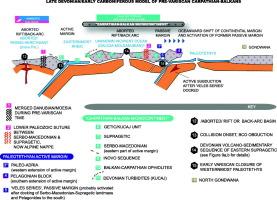重建神秘的前variscan古地理构造的西部围moesian领域(喀尔巴阡-巴尔干半岛,塞尔维亚东部):对泥盆纪小尺度大陆和古海洋单元的洞察
IF 10
1区 地球科学
Q1 GEOSCIENCES, MULTIDISCIPLINARY
引用次数: 0
摘要
喀尔巴阡-巴尔干提供了两个不同但规模有限的北冈瓦纳带状古大陆在瓦里斯坎泥盆纪碰撞开始之前是如何相互作用的见解:(i)漂移的“喀尔巴阡-巴尔干微大陆”(塞尔维亚-马其顿/上陆/地陆(ku本文章由计算机程序翻译,如有差异,请以英文原文为准。

Reconstruction of the enigmatic pre-Variscan paleogeographic configuration of the western peri-Moesian realm (Carpathian-Balkans, eastern Serbia): An insight into Devonian small-scale continental and paleo-oceanic units
The Carpathian-Balkans provide insight into how two distinct but limited-sized north Gondwanan ribbon-shaped paleocontinents interacted prior to the Variscan Devonian collisional onset: (i) the drifted “Carpathian-Balkan microcontinent” (Serbo-Macedonian/Supragetic/Getic(Kučaj)) and (ii) the already amalgamated Avalonian Danubian-Moesian basement fragment with its Devonian suture elements. These two crustal fragments were separated by the intervening Rheic Ocean during the Devonian. Despite the investigated eastern Variscan collisional assembly being stacked near the overprinted promontory of the East European Craton, its sliced basement segments and their Devonian record are well exposed in eastern Serbia. The synthesis reveals that the sliced Carpathian-Balkan inliers play a crucial role in understanding the lithospheric-scale movement of smaller continental terranes from north Gondwana and their suturing modes related to the surrounding Paleozoic oceans. An analysis of geochemical, paleogeographic, and regional geological data reveals that continental and oceanic paleoenvironments existed prior to and during the Devonian period, merging with the already amalgamated Danubian block and the Moesian microplate. Nonetheless, despite the well-preserved Devonian record found in eastern Serbia, the Romanian South Carpathians, and western Bulgaria, only a limited number of reconstructions clarify the pre-Variscan tectono-paleogeographic setting.
After a few rift-drift cycles connecting north Gondwana and southern Laurussia, the tectonic transport of Cadomian to Cenerian peripheral terranes from northern Gondwana begun with the post-Ordovician rifting off. The rifting led to the formation of narrow, elongated crustal segments. The outboard Lower Paleozoic ribbon-shaped paleocontinent, including its Carpathian-Balkan continental fragment, occupied a position between two principal Paleozoic oceans. On the southern flank of the exotic narrow Lower Paleozoic microcontinent, we demonstrate for the first time the presence of a continental extension of Devonian age, likely associated with the adjacent Paleotethyan Ocean. The synthesis further demonstrates that the volcano-sedimentary protoliths of Devonian-aged greenschist facies rocks, which traverse the continental Serbo-Macedonian/Supragetic/Getic Devonian microcontinent, serve as markers of Early Devonian (back-arc) rifting. On its opposite Eurasian flank towards Danubian/Moesia, following the accumulation of Silurian–Early Devonian deep-water sediments, the Kučaj(Getic) turbidites, along with the expanding Middle to Late Devonian oceanic crust (Danubian ophiolites), belonged to the Rheic Ocean. The geochemical modeling of Devonian ophiolites reveals that this Balkan-Carpathian ocean displays both mid-ocean ridge basaltic (Tisoviţa Iuţi, Deli Jovan) and volcanic arc/back-arc signatures (Zaglavak, Tcherni Vrah). The extracted petrographic and regional geological constraints confirm the short transport of eroded material from the eroded Serbo-Macedonian/Supragetic narrow elongated landmass into the Late Devonian (Carboniferous) Kučaj(Getic) trench turbidites. Geochemical signatures outline the intraoceanic character of this frontal pre-Variscan subduction-driven active margin. The proposed new Devonian reconstruction updates the existing paleogeographic constraints on the opposite Avalonian block, revealing that the narrow Devonian ocean and its subduction beneath the Avalonian “micro-terranes” (Danubian/Moesia) produced an epicontinental basin with Devonian volcanism assigned to the Hanseatic-type rifting off processes.
求助全文
通过发布文献求助,成功后即可免费获取论文全文。
去求助
来源期刊

Earth-Science Reviews
地学-地球科学综合
CiteScore
21.70
自引率
5.80%
发文量
294
审稿时长
15.1 weeks
期刊介绍:
Covering a much wider field than the usual specialist journals, Earth Science Reviews publishes review articles dealing with all aspects of Earth Sciences, and is an important vehicle for allowing readers to see their particular interest related to the Earth Sciences as a whole.
 求助内容:
求助内容: 应助结果提醒方式:
应助结果提醒方式:


